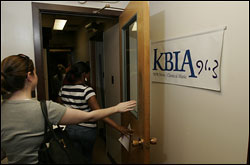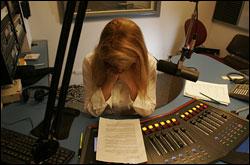Convergence Project Helps Magazine Journalism Students Learn Radio Skills
By Katie Costello
Columbia, Mo. (Oct. 31, 2006) — When Katy June-Friesen signed up for Mary Kay Blakely‘s advanced writing class at the Missouri School of Journalism, she had no idea that she would be producing a broadcast feature for KBIA, the University of Missouri’s National Public Radio member station.
Students in Blakely’s and Berkley Hudson‘s advanced writing classes write and produce their own oral commentaries in addition to longer feature assignments for print publications. The students write NPR-style commentaries on different social issues or other topics of interest. The point is to tell a story that is compelling, interesting and entertaining.

Blakely started the assignment four years ago because she wanted students to learn different styles of writing and how to use different mediums to display that writing. She and Hudson are magazine journalism faculty members.
“In today’s world, with all the changing technology, it’s important for writers to become multimedia,” said Blakely. When Hudson joined the magazine journalism faculty in the fall of 2003, he teamed up with Blakely because he thought it was a great assignment. For Hudson, the purpose of the assignment is to get students to feel comfortable in different settings.
“In radio, you are writing things in short form. This can be challenging for our students, because they are used to writing articles several pages long. However, it’s important to learn how to cut things down and focus on the important aspects,” said Hudson.
Once the students have completed several drafts of their commentary, outside experts such as Maeve McGoran help them prepare their pieces for radio. McGoran, the senior commentary editor for NPR’s “Morning Edition,” said that the show uses pieces that relate to an issue in the news or that relate to a bigger context. McGoran also noted that writing for the ear demands a simpler sentence structure, words with fewer syllables and a style that is easy to listen to.
“NPR is very competitive,” said McGoran. She receives approximately 100 submissions a week and only five get aired.
“A couple students have had some really great pieces, and we have tried to run them, but haven’t been able due to time constraints and the competitiveness of NPR,” said McGoran.
The high quality of the work and performance does allow KBIA to air many of the students’ commentaries.

Sarah Ashworth, KBIA news director and a member of the radio-television journalism faculty, also works with the students to help them with the on-air aspect of the assignment. She said that is very challenging to write compelling radio. “It is important for these commentaries to be interesting and have a conversational tone. A student may write something amazing, but if it can’t be performed well, then it won’t work for radio,” Ashworth said.
Writing for radio proved to be a big challenge for June-Friesen.
“I was used to writing 12-page articles, and my commentary had to be around two pages. It was really difficult to cut things out, but this made me focus on what was important,” she said.
June-Friesen also liked personalizing the content of the commentaries and performing it.
“It was really cool to use all the different editing programs and using things to be able to manipulate my sound,” she noted.
Calli Hodge, a senior magazine journalism student, said that she had a difficult time coming up with a topic that was witty and fun.
“I wanted to pick something that people could laugh about and would want to listen to. It took me a long time to get a good idea, but I finally decided to write about how my mom has replaced me with the dog,” said Hodge.

Another challenge Hodge faced was altering to a different sentence structure and writing a script that was punchy.
“It is a lot different writing for the ears versus the eye. You have to think of catchy phrases and words that work well with your voice. The commentary also needs to be easy to listen, too,” she said.
Many of the students who have taken this class agree that working with radio is a good experience to have. Rhitu Chatterjee, a graduate student, took advanced writing last fall and realized radio involved a lot of creativity, more than she previously thought.
“The writing is very different than writing for print, but allows more creative freedom. It is very rewarding,” said Chatterjee. The experience also opened a learning opportunity for Chatterjee who interned with NPR in Washington, D.C., this summer.
The lesson, according to the course’s students, is to not be afraid of doing something you have never done before.
“These new experiences teach students how to adapt and, more times than not, people often enjoy learning the new skills. They may even end up with a new career possibilities,” said June-Friesen.
Updated: April 13, 2020